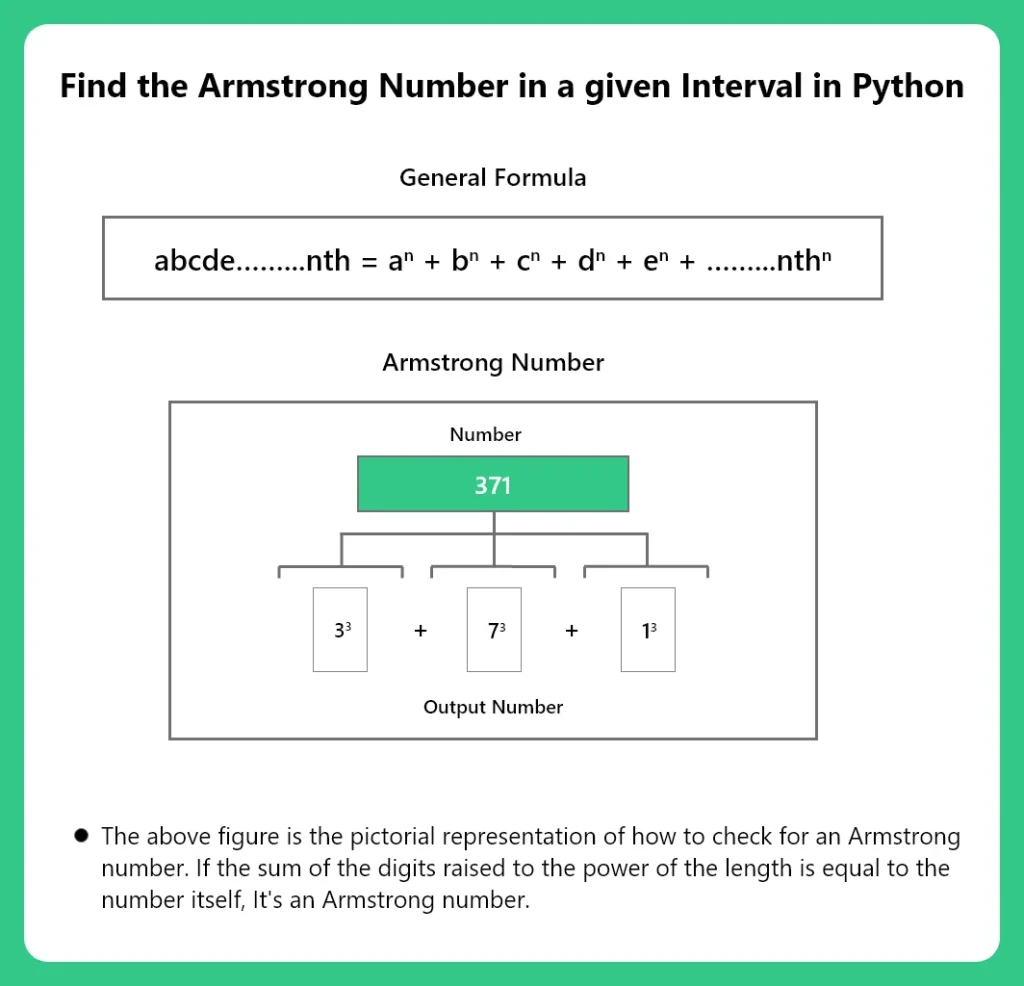Find the Armstrong Numbers between Two Intervals using Python
Find the Armstrong Number in a given Range in Python
Given two integers high and low for limits as inputs, the objective is to write a code to Find the Armstrong Numbers in a given Interval in C++.
For Instance, Input : 150 160 Output : 153

Find the Armstrong Numbers in a given Range in Python
Given two integer inputs as intervals high and low, the objective is to write a python code to check if the numbers lying within the given interval are Armstrong Numbers or not.
An Armstrong number or a Narcissistic number is any number that sums up itself when each of its digits is raised to the power of a total number of digits in the number. Let us try to understand this through the below example,
- abcd… = an + bn + cn + dn + …
- Where n is the order(length/digits in number)
Let’s look at some examples of Armstrong Numbers.
Examples
Here are few examples that’ll help you to understand the concept better.

370 = 3^3 + 7^3 + 0^3
= 27 + 343 + 0
= 370
1634 = 1^4 + 6^4 + 3^4 + 4^4
= 1 + 1296 + 81 + 256
= 1634
Method 1
Python Code
low, high = 10, 10000
for n in range(low, high + 1):
# order of number
order = len(str(n))
# initialize sum
sum = 0
temp = n
while temp > 0:
digit = temp % 10
sum += digit ** order
temp //= 10
if n == sum:
print(n, end=", ")
Method 2
Python Code
import math
first, second = 150, 10000
def is_Armstrong(val):
sum = 0
# this splits the val into its digits
# example val : 153 will become [1, 5, 3]
arr = [int(d) for d in str(val)]
# now we iterate on array items (digits)
# add these (digits raised to power of len i.e order) to sum
for i in range(0, len(arr)):
sum = sum + math.pow(arr[i], len(arr))
# if sum == val then its armstrong
if sum == val:
print(str(val) + ", ", end="")
for i in range(first, second + 1):
is_Armstrong(i)
Output
153, 370, 371, 407, 1634, 8208, 9474,
Prime Course Trailer
Related Banners
Get PrepInsta Prime & get Access to all 200+ courses offered by PrepInsta in One Subscription
- Positive or Negative number: C | C++ | Java | Python
- Even or Odd number: C | C++ | Java | Python
- Sum of First N Natural numbers: C | C++ | Java | Python
- Sum of N natural numbers: C | C++ | Java | Python
- Sum of numbers in a given range: C | C++ | Java | Python
- Greatest of two numbers: C | C++ | Java | Python
- Greatest of the Three numbers: C | C++ | Java | Python
- Leap year or not: C | C++ | Java | Python
- Prime number: C | C++ | Java | Python
- Prime number within a given range: C | C++ | Java | Python
- Sum of digits of a number: C | C++ | Java | Python
- Reverse of a number : C | C++ | Java | Python
- Palindrome number: C | C++ | Java | Python
- Armstrong number : C | C++ | Java | Python
- Armstrong number in a given range : C | C++ | Java | Python
- Fibonacci Series upto nth term : C | C++ | Java | Python
- Find the Nth Term of the Fibonacci Series : C | C++ | Java | Python
- Factorial of a number : C | C++ | Java | Python
- Power of a number : C | C++ | Java | Python
- Factor of a number : C | C++ | Java | Python
- Strong number : C | C++ | Java | Python
- Perfect number : C | C++ | Java | Python
- Automorphic number : C | C++ | Java | Python
- Harshad number : C | C++ | Java | Python
- Abundant number : C| C++ | Java | Python
- Friendly pair : C | C++ | Java | Python

Login/Signup to comment






n1=int(input(‘enter the first range’));
n2=int(input(‘enter the second range’));
arr=[];
for i in range(n1,n2+1):
temp=i;
sum=0;
for j in str(i):
j=int(j);
j=j**3;
sum=sum+j;
if(temp==sum):
arr.append(sum);
print(‘The Armstrong Numbers Within the Range are’,arr);
for i in range(int(input()),int(input())):
temp=i
sum=0
while temp != 0:
digit = int(temp % 10)
sum += (digit ** 3)
temp = int(temp / 10)
if sum==i:
print(sum)
else:
pass
n=int(input(‘Number : ‘))
x=str(n)
p=len(x)
amstrong=0
for i in x:
amstrong+=int(i)**p
if n==amstrong:
print(“Amstrong”)
else:
print(“Not Amstrong”)
lower_number = int(input(“Enter any positive number: “))
higher_number = int(input(“Enter any positive number: “))
for i in range(lower_number,higher_number+1):
sum = 0
length = len(str(i))
original = i
while i > 0:
digit = i % 10
sum += digit ** length
i = i // 10
if sum == original:
print (original ,end=”, “)
num1=int(input(“Enter lower number: “))
num2=int(input(“Enter higher number: “))
for num in range(num1, num2 + 1):
order = len(str(num))
sum = 0
temp = num
while temp > 0:
digit = temp % 10
sum += digit ** order
temp //= 10
if num == sum:
print(num)